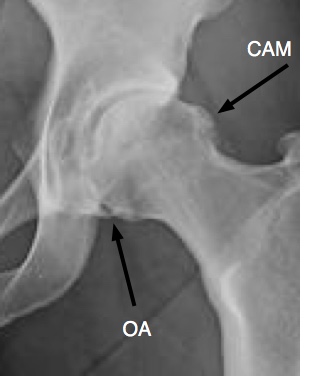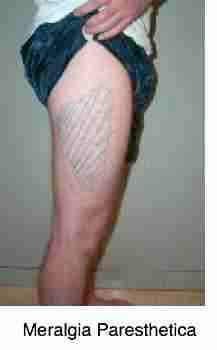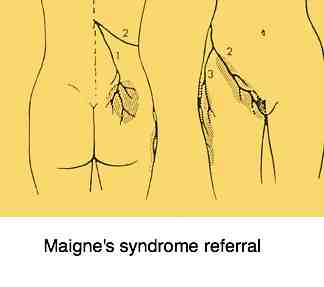- Bernard Preston homepage
- One day
- Upper Leg Thigh and Groin Pain
Upper leg, thigh and groin pain
Upper leg, thigh and groin pain are common complaints at the DC's coalface. The first thought is a hip condition like an impingement syndrome or dysplasia; but it could be referred tingling and numbness from the femoral nerve.
There are also slips like the lateral femoral cutaneous nerve that pass through the groin where it can be pinched causing a burning pain and numbness on the side of the upper leg or thigh.
 Femoral acetabular impingement syndrome
Femoral acetabular impingement syndromeA typical case history might run something like this. A middle aged woman decides she needs to get into shape and joins an aerobics class; whilst doing a leg kick-back thrust she feels a stab of pain in the lower back. Upon waking the next morning she is unable to get out of bed.
Any movement of the leg causes severe lower back pain radiating to the upper thigh and groin.
This page was last updated by Dr Bernard Preston on 9th November, 2023.
Another fairly typical story of upper leg and groin pain might run like this. A woman has had an ache and thigh tightness for some months; it used to go away after stretching and walking but now these activities no longer relieve the discomfort.
The upper thigh muscle feels very tight when walking even short distances; sitting makes her stiff and seems to affect her gait. Sometimes the pain radiates to the buttock muscle. About a year ago she had a hard fall on the butt whilst out jogging requiring medical treatment on the opposite hip.
There are many variations of this theme.
Yet another person experiences it in this way. "I get sharp, intermittent stabs in my right groin and inner thigh; then lifting my leg and walking become difficult. It seems to involve the thigh muscle but I also have hip pain on the same side at night periodically."
She has had a knee replacement on the same side. She also sleeps on her stomach giving her a lot of lower back pain in the morning.
And then our last case of upper leg, thigh and groin pain is an elderly man in his eighties. He has discomfort in the femur and in the sacroiliac joint area; it too affects walking and is particularly bad when trying to raise his knee whilst sitting.
Upper leg, thigh and groin pain
Upper leg, thigh and groin pain may be referred from the spine, sacroiliac joint or a hip condition.
Notice the common threads that run through these stories; firstly they are mainly women, some young and others elderly, but that may be incidental.
Then there is in all cases either some lower back or buttock pain; this could be secondary to a hip condition, or it could be the cause of the discomfort.
Then raising the leg, as in getting into the car, may be painful, but it's not necessarily so. Sometimes there is a known cause of the difficulty, but in other cases the onset is insidious. They often complain more of disability than pain; it impedes their every day lives making walking, getting out of a chair and generally getting about awkward.
Sometimes there is night pain, but not in all cases.
Let's first consider that night pain; it is one of the red flags in making a diagnosis. If there is any history of tumours, particularly of the prostate, large bowel, ovaries or kidneys, an x-ray of the area is mandatory. Metatases to the spine and pelvis are not common, but remember these are sometimes silent diseases and the first manifestation may be a history like one of the above.
Femoro acetabular impingement syndrome
Femoro acetabular impingement syndrome is one of the most common causes of upper leg, thigh and groin pain; it starts in the young person causing stiffness in the hip that is only rarely recognised as being abnormal; it is a silent disease, the pain only beginning in the twenties and thirties unless the person is sporty.
If there is a family history of hip disease then every single hip of the offspring needs to be examined for femoro acetabular impingement syndrome; it's a primary cause of arthritis, yet a simple, faithfully done mobilising exercise may prevent a lifetime of misery.
A bony growth, either on the socket or neck of the upper thigh, or both, impinges on the labrum of the acetabulum; causing premature degenerative change and early disabling pain in the groin and hip.
I am sure you can easily visualise the huge CAM deformity in the above x-ray with early degenerative change in the lower hip.
A gentle set of mobilising exercises will polish off those rough spots but if nothing is done, full blown arthritis is in the making with an early hip replacement.
Hip dysplasia
Hip dysplasia casefiles are also a common cause of upper leg, thigh and groin pain. The more serious ones that dislocate regularly are usually caught by the paediatrician at birth, but milder cases still cause very disabling discomfort, often in young adults.
Just to thrown in a boomerang, pubic bone pain can mimic all this too.
Use the Site Search function to find the links to those topics highlighted in bold.
Hip arthritis
The causes of hip arthritis make interesting reading but in every case there is a history of upper leg, thigh and groin pain.
Much has been researched, but there is a large speculative element too. Three main causes are well researched.
- A short leg.
- Femoro acetabular impingement syndrome
- Hip dysplasia.
Over and above that we DCs believe that a chronic sacroiliac fixation may change the gait and ultimately cause hip arthritis; but it is chicken and egg.
Add to that trauma to the hip such as heavy falls on the buttocks and especially the sacrum, or motor accidents where the knee hits the dashboard and you have multiple causes of hip arthritis; that tumble from a horse twenty years ago?
It is good to remember too that health hazards are additive; if you have a short leg and a family history of hip dysplasia, for example, then you are far more likely to get arthritis.
Femoral nerve
The femoral nerve supplies the upper leg, thigh and groin. Many of these pains have their origin in an irritated disc or facet in the mid to upper lumbar spine.
As a rule of thumb, younger folk tend to have lower lumbar syndromes with a sciatic nerve radiation.
On the other hand, older folk tend to have more problems higher in the lumbar spine affecting the femoral nerve; this is a generalisation and certainly no hard and fast rule.
Personally I have had a sequestered mid lumbar disc, with an extrusion into the intervertebral foramen; the upper leg and thigh pain was excruciating, but the groin was spared. Only spinal manipulation par excellence saved me from going under the knife. It's now six years since that prolapse; whilst I still get some tingling and numbness in the leg, I am able to do everything. This afternoon I spent two hours with the chainsaw cutting up a large trunk for firewood that an ill wind brought down. It was heavy work; but I never miss my lower back exercises.
A slipped disc in the lumbar spine is a very painful affair, particularly if there is radiating leg pain; it must be taken seriously. The sciatic nerve tends to affect the back of the thigh and calf, and either the side of the foot or around the big toe.
The femoral nerve on the hand affects the front of the upper thigh and less frequently an ache in the groin; then it often continues down the inner lower limb.
- Femoral nerve damage
- Lower back exercises
Meralgia paresthetica

Meralgia paresthetica is a double crush syndrome. The lateral femoral cutaneous nerve is irritated in both the lumbar spine and in the groin; numbness and sometimes pain on the side of the upper leg and thigh.
Maigne's syndrome

Maigne's syndrome casefile is the last in our smorgasbord of conditions that may cause upper leg, thigh and groin pain. It is often missed as the site of pinching of the nerve is remote, at the junction of the thoracic and lumbar spine; much higher up in the back.
The superior cluneal nerves supply the buttock certainly but anatomists disagree whether the groin is affected.
Every experienced DC knows to check the T12/L1 area in cases of gluteal and groin pain.
Pubic bone pain is not uncommon too.
When browsing use right click and "Open Link in New Tab" or you may get a bad gateway signal.
Newsletter
Our newsletter is entitled "create a cyan zone" at your home, preserving both yourself and Mother Earth for future generations; and the family too, of course. We promise not to spam you with daily emails promoting various products. You may get an occasional nudge to buy one of my books.
Here are the back issues.
- Lifestyle and ideal body weight
- What are ultra-processed foods?
- Investing in long-term health
- Diseases from plastic exposure
- Intensive lifestyle management for obesity has limited value
- A world largely devoid of Parkinson's Disease
- The impact of friendly bacteria in the tum on the prevention of cancer
- There's a hole in the bucket
- Everyone is talking about weight loss drugs
- Pull the sweet tooth
- If you suffer from heartburn plant a susu
- Refined maize meal and stunting
- Should agriculture and industry get priority for water and electricity?
- Nature is calling
- Mill your own flour
- Bake your own sourdough bread
- Microplastics from our water
- Alternative types of water storage
- Wear your clothes out
- Comfort foods
- Create a bee-friendly environment
- Go to bed slightly hungry
- Keep bees
- Blue zone folk are religious
- Reduce plastic waste
- Family is important
- What can go in compost?
- Grow broad beans for longevity
- Harvest and store sunshine
- Blue zone exercise
- Harvest and store your rainwater
- Create a cyan zone at your home
Use the Site Search function in the navigation bar on your left to find the links to those topics such as femoral nerve damage and lower back exercises above; and meralgia paresthetica below, highlighted in bold.
Did you find this page interesting? How about forwarding it to a friendly book or food junkie? Better still, a social media tick would help.
- Bernard Preston homepage
- One day
- Upper Leg Thigh and Groin Pain
Address:
56 Groenekloof Rd,
Hilton, KZN
South Africa
Website:
https://www.bernard-preston.com